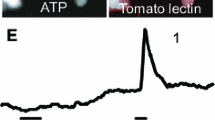Summary
We have isolated and characterized a population of brain macrophages from normal and scrapieinfected mice. The cells are phagocytic, possess Fc-IgG receptors, Mac-1 surface antigen and proliferate in the presence of macrophage colony stimulating factor. They resemble microglia in that they have a plasmalemmal distribution of the enzyme nucleoside diphosphatase, a property that is characteristic of microglia in situ. In two of the three combinations of scrapie agent and mouse strain examined, the number of brain macrophages was several fold higher than in normal control mice. The increase was not observed in mice infected intraperitoneally or in control mice inoculated with normal brain homogenate. The increase is detectable as early as 3–5 weeks postinoculation. The agent/host combination that failed to show an increase in brain macrophages is one that develops large numbers of amyloid plaques. These observations suggest that these cells are closely associated with the scrapie pathogenic process in the CNS. The failure of these cells to increase in the plaque forming model of scrapie disease also suggests that they play a role in the control of CNS amyloidogenesis.
Similar content being viewed by others
References
Carp RI, Callahan SM (1981) In vitro interaction of scrapie agent and mouse peritoneal macrophages. Intervirology 16:8–13
Carp RI, Callahan SM (1982) Effect of mouse peritoneal macrophages on scrapie infectivity during extended in vitro incubation. Intervirology 17:201–207
Carp RI, Callahan SM (1985) Effect of prior treatment with thioglycollate on the incubation period of intraperitoneally injected scrapie. Intervirology 24:170–173
Dickinson AG, Fraser H, McConnell I, Outram GW (1978) Mitogenic stimulation of the host enhances susceptibility to scrapie. Nature 272:54–55
Durie BGM, Persky B, Svehnlen BJ, Grogan TM, Salmon SE (1982) Amyloid production in human myeloma stem cell culture with evidence of amyloid secretion by associated macrophages. N Engl J Med 307:1689–1692
Ehlers B, Rudolph R, Diringer H (1984) The reticuloendothelial system in scrapie pathogenesis. J Gen Virol 65:423–428
Eklund CM, Kennedy RC, Hadlow WJ (1967) Pathogenesis of scrapie virus infection in the mouse. J Infect Dis 117:15–22
Fraser H (1979) Neuropathology of scrapie: the precision of the lesions and their diversity. In: Prusiner SB, Hadlow WB (eds) Slow transmissible diseases of the nervous system, vol 1. Academic Press, New York, pp 387–405
Fraser H, Dickinson AG (1970) Pathogenesis of scrapie in the mouse: the role of the spleen. Nature 226:462–463
Fraser H, Dickinson AG (1978) Studies of the lymphoreticular system in the pathogenesis of scrapie: the role of spleen and thymus. J Comp Pathol 88:563–573
Kascak RJ, Rubenstein R, Merz PA, Carp RI, Robakis NK, Wisniewski HM, Diringer H (1986) Immunological comparison of scrapie associated fibrils isolated from animals infected with four different scrapie strains. J Gen Virol 59:676–683
Kedar I, Ravid M (1980) Granulocytes and T-lymphocytes in casein induced murine amyloidosis. In: Glenner GG, Costa PP, Falcao de Freitas A (eds) Amyloid and amyloidosis. Excerpta Medica, Amsterdam, pp 524–526
Kimberlin RH (1979) Early events in the pathogenesis of scrapie in mice: Biological and biochemical studies. In: Prusiner SB, Hadlow WJ (eds) Slow transmissible diseases of the nervous system, vol 2. Academic Press, New York, pp 33–54
Kimberlin RH, Cunnington PG (1978) Reduction of scrapie incubation time in mice and hamsters by a single injection of methanol extraction residue of BCG. FEMS Microbiol Lett 3:169–172
Kisilevsky R (1983) Biology of disease. Amyloidosis: a familiar problem in the light of current pathogenetic developments. Lab Invest 19:381–390
Metcalf D (1984) The hemopoietic colony stimulating factors. Elsevier, Amsterdam, pp 67–70
Moretz RC, Wisniewski HM, Lossinski AS (1983) Pathogenesis of neuritic and amyloid plaques in scrapie. Ultrastructural study of early changes in the cortical neuropil. In: Samuel D (ed) Aging of the brain. Raven Press, New York, pp 61–79
Murabe Y, Sano Y (1981) The thiamine pyrophosphatase activity in the plasma membrane of the microglia. Histochemistry 71:45–52
Springer T, Galfre G, Secher DS, Milstein C (1979) Mac-1: a macrophage differentiation antigen identified by monoclonal antibody. Eur J Immunol 9:301–306
Stanley ER, Chen DM, Lin HS (1978) Induction of macrophage production and proliferation by a purified colony stimulating factor. Nature 274:168–170
Vorbrodt AW, Wisniewski HM (1982) Plasmalemma-bound nucleoside diphosphatase as a cytochemical marker of the central nervous system (CNS) mesodermal cells. J Histochem Cytochem 30:418–424
Wisniewski HM, Bruce ME, Fraser H (1975) Infectious etiology of neuritic (senile) plaques in mice. Science 190:1108–1110
Wisniewski HM, Moretz RC, Lossinsky AS (1981) Evidence for induction of localized amyloid deposits and neuritic plaques by an infectious agent. Ann Neurol 10:517–522
Wisniewski HM, Vorbrodt AW, Moretz RC, Lossinski AS, Grundke-Iqbal I (1982) Pathogenesis of neuritic (senile) and amyloid plaque formation. Exp Brain Res [Suppl] 5:3–9
Author information
Authors and Affiliations
Additional information
Dedicated to Prof. F. Seitelberger on the occasion of his seventieth birthday
Supported by National Institute on Aging grant no. AG04220
Rights and permissions
About this article
Cite this article
Merz, G.S., Schwenk, V., Schuller-Levis, G. et al. Isolation and characterization of macrophages from scrapie-infected mouse brain. Acta Neuropathol 72, 240–247 (1987). https://doi.org/10.1007/BF00691096
Received:
Accepted:
Issue Date:
DOI: https://doi.org/10.1007/BF00691096




